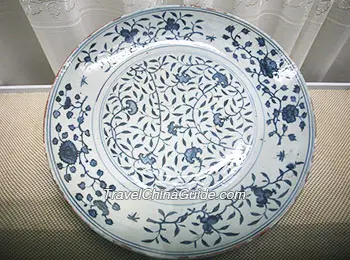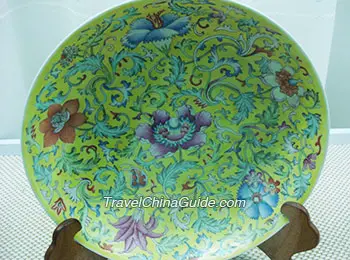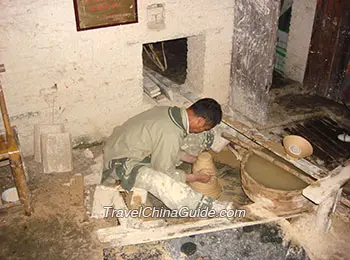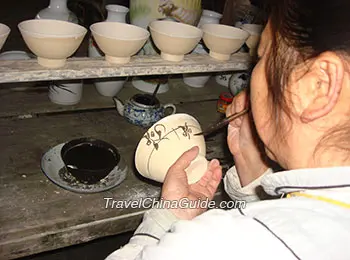Jingdezhen Porcelain
Jingdezhen Porcelain is the most well-known type of Chinese porcelain, originating from Jingdezhen city, Jiangxi Province in southern China. It is characterized by fine quality, graceful shapes and elaborate patterns, representing the classical ceramic art all around the world. It can be used as tableware like plates and bowls, building materials like tiles, or house decorations like vases and sculptures, etc.
7 Main Types of Jingdezhen Porcelain
1. Ling-lung ware/ Rice-pattern decorated porcelain
Ling-lung ware has a history of more than five hundred years and features a piercing technique. Before applying a coating glaze material and burning in the kiln, the craftsman uses a knife to pierce through the clay body to make many tiny holes. The semitransparent holes make the porcelain look very elegant.
2. Blue-white porcelain
Chinese name: 青花瓷 qīng huā cí
Blue-white porcelain is the most well-known type among all the Jingdezhen Porcelains. Its developmental process took shape during the Ming and Qing Dynasties (1368-1911). Craftsman uses cobalt oxide to paint the design on the clay body. After glazing and burning, the elaborate indigo pattern will appear on the white surface. The common patterns include lotus, peony, bamboo, cypress, peacock, dragon, phoenix, and so on.
Blue-white porcelain is the most well-known type among all the Jingdezhen Porcelains. Its developmental process took shape during the Ming and Qing Dynasties (1368-1911). Craftsman uses cobalt oxide to paint the design on the clay body. After glazing and burning, the elaborate indigo pattern will appear on the white surface. The common patterns include lotus, peony, bamboo, cypress, peacock, dragon, phoenix, and so on.
|
|
3. Famille rose porcelain
Chinese name: 粉彩瓷 fĕn căi cí
Famille rose porcelain is popular for its on-glaze decoration. The outline of the pattern is drawn on the white porcelain first, then filled with color and fired at over a 700℃ (1,300℉) temperature. In this way, the pattern on the porcelain will be clear and soft. Generally, the patterns vary among figures from Chinese history or myth, landscape, animals and symmetrical patterns.
Famille rose porcelain is popular for its on-glaze decoration. The outline of the pattern is drawn on the white porcelain first, then filled with color and fired at over a 700℃ (1,300℉) temperature. In this way, the pattern on the porcelain will be clear and soft. Generally, the patterns vary among figures from Chinese history or myth, landscape, animals and symmetrical patterns.
4. Color porcelain
Unlike the above types, the main porcelain body is done in color. This is achieved by a skillful change in the amount of trace elements in the glaze material. For example, copper is for red, cobalt for indigo, ferrum for black and plumbum for green. Experienced craftsmen are able to combine different colors, so as to make a gorgeous color porcelain.
5. Thin china
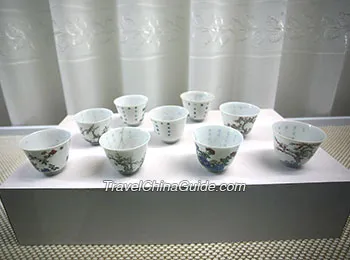 |
| Thin china |
Thin china is also called eggshell porcelain. As the name implies, this type of Jingdezhen Porcelain stands out for its ultra-thinness. The clay body needs to be polished hundreds of times, through which the thickness will be reduced gradually. The finished porcelain is translucent and very dainty.
6. Statuary porcelain
Statuary porcelain has a history of more than 1,400 years. It can be in the shape of the Buddha, animals, insects, flowers, miniature architectural structures, and so on. Through a combination of graceful shape and gorgeous color, statuary porcelain can be very vivid.
7. Shadowy blue ware
Shadowy blue ware is a relatively new type of Jingdezhen Porcelain designed in 1983. The under-glazed blue-white pattern and on-glazed decoration add radiance to each other, truly unique.
History of Jingdezhen Porcelain for More Than 1,600 Years
How to Make Jingdezhen Porcelain – 5 Basic Steps
|
|
Where is Jingdezhen Porcelain used nowadays?
- Last updated on Aug. 07, 2025 by Gabby Li -
